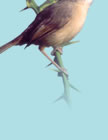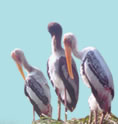
|

|
Bird Watching Tips
Tip1
You need a field guide for your area. Take a bird book with you.
Tip 2
You need a binocular to see the birds. The best birders have powerful
binoculars -- even though they can identify a bird 100 yards away by its silhouette.
Tip 3
You need to know what to expect in your area.
Tip 4
You need to be able to find the birds. To do this, you should learn
about the habitat each species of bird prefers.
Tip 5
Join a group of other birders. Birders are very friendly and helpful.
They are always willing to share their knowledge. We were all beginners once.
Bird Watching Techniques
A bird-watcher and his or her binoculars are practically a cliche. But
that's true for a reason. There are few things better suited for this hobby in which
participants are trying to get a close look at a subject that tends to be elusive
and hard to approach.
- Binoculars come in a range of sizes, styles and levels of quality. Because they
are so important, it's best to purchase the best pair you can reasonably afford.
Binoculars well suited for bird-watching generally start in a price around Rs 10,000
and may range upward of Rs 45,000.
- Each pair of binoculars has a number associated with it -- such as 8x42
-- and the numbers should be marked clearly on the binoculars themselves. The first
number (8) represents the degree of magnification offered by the
binoculars, so in this example, the binoculars would enlarge the image 8 times larger
than that of the naked eye. The second number (42) gives the diameter, in millimeters,
of the objective lens (the front lens) of the binocular. A higher
second number means that the lens lets in more light. More light means that the
image seen through the binoculars will be brighter and more clear.
- When using binoculars, avoid looking through the binoculars as you "look
around." Instead, spot the bird you want to view using your naked eye, then
carefully bring the binoculars up to your eyes while keeping the bird in view --
without moving your head or changing the direction you're looking.
- For the serious bird-watching enthusiast, another useful tool is the scope.
These specialized telescopes are typically mounted on tripods and are more powerful
than binoculars. They start at magnifications of 15 or 20, and some go much higher.
- Some scopes have zoom attachments that allow you to variably decrease or increase
magnification up to as much as 60x. Other features include a separate focus knob
and a tripod and handle that allows tilting and panning for easy viewing in all
directions.
|

|
|

|

